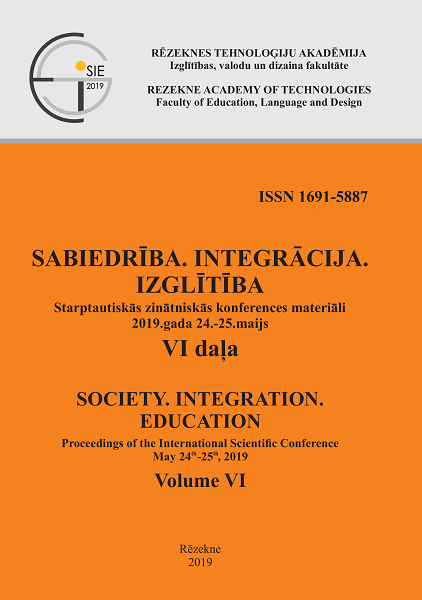BUSINESS MODEL COMPLEMENTARITY AND THE FACTORS THAT DETERMINE IT IN TOURISM BUSINESS FORMATIONS: THE THEORETICAL ASPECT
DOI:
https://doi.org/10.17770/sie2019vol6.3688Keywords:
business model, complementarity, incoming tourismAbstract
In order to reveal the complementarity of business models, the factors that determine it in incoming tourism, and to prepare the conceptual model, the following discussion questions should be answered (the research problem is formulated by presenting questions in theoretical context): what is a business model and its structure?; what is business model complementarity?; what traits and identification characteristics are characteristic of it?; what factors determine business model complementarity in incoming tourism? The aim of the research – theoretically substantiate the traits and characteristics of business model complementarity and the factors that determine it in incoming tourism by preparing a conceptual model. Research methods: systematic analysis of scientific literature, comparative analysis. The key results of the research: the concepts and structures of a business model, complementarity and business model complementarity are defined by systematising conceptual insights, interorganizational relations and complementarity; according to the systemic point of view that explains the result of the interaction between an incoming tourism company business model and its structural elements, the conceptual model of business model complementarity and the factors that determine it in incoming tourism, are presented.
References
Baggio, R., Scott, N., & Cooper, C. (2010). Network science - a review with a focus on tourism. Annals of Tourism Research, 37(3), 802–827
Ballot, G., Fakhfakh, F., Galia, F., Salter, A. (2011). The fateful triangle: Complementarities in performance between product, process and organizational innovation in France and the UK. Research Policy, 44 (1), 217-232.
Bethapudi, A. (2013). The Role of ICT in Tourism Industry. Journal of Applied Economics and Business, 1(4), 67-79.
Buhalis, D. and Foerste, M. (2015). SoCoMo Marketing for Travel and Tourism: empowering co-creation of value. Journal of Destination Marketing & Management. Retrieved from: http://dx.doi.org/10.1016/j.jdmm.2015.04.001
Buhalis, D., & Law, R. (2008). Progress in informatikon technology and tourism management: 20 years on and 10 years after the Internet-The state of eTourism research. Tourism management, 29(4), 609-623.
Casadesus-Masanell, R. & Ricart, J.E. (2010). From strategy to business models and onto tactics. Long Range Planning, 43(2-3): 195-215.
Cavaco S. and Crifo, P. (2014). CSR and Financial Performance: Complementarity between Environmental, Social and Business Behaviours. Applied Economics, 46(27), 3323-3338.
Chesbrough, H. (2010). Business model innovation: opportunities and barriers. Long Range Planning, 43 (2/3), 354–363.
Dyer, J. & Singh, H. (1998). The relational view: Cooperative strategy and sources of interorganizational competitive advantage. Academy of Management Review, 23 (4), 660–679.
Ennen E. & Richter A. (2010). The Whole is More Than the Sum of Its Parts-Or is It? A Review of the Empirical Literature on Complementarities in Organizations. Journal of Management, 36 (1), 207-233.
Eungblut, S. (2011). PESTLE and Porter’s 5 Forces Analysis: Two Crucial Concepts for Business Leaders & Sales People. Retrieved from http://sterlingchase.com/2011/09/27/pestle-and-porters-5-forces-analysis-two-crucial-concepts-for-business-leaders-salespeople/3/
Fundeanua, D. (2015). Innovative Regional Cluster, Model of Tourism Development. Procedia Economics and Finance, 23, 744 – 749.
Granados, N., Gupta, A. & Kauffman, R. J. (2012). Online and offline demand and price elasticities: Evidence from the air travel industry. Information Systems Research, 23 (1), 164-181.
Grandori, A., Furnari S. (2009). Types of Complementarity, Combinative Organization Forms and Structural Heterogeneity: Beyond Discrete Structural Alternatives. In: M. Morroni (Ed.). Corporate Governance, Organization and the Firm: Co-operation and Outsourcing in a Globalised Market. London, UK: Edward Elgar. (pp. 63-86).
Haubro, A.P., Lomholt, H.A., Lueg, R., Nielsen, S.V., Knudsen, U. (2015). Tactical and strategic choices in business models: evidence from a Danish fashion outlet. Journal of Fashion Marketing and Management, 19 (3), 274-289.
Kavusana, K., Noorderhavenb, N.G., Duysters, G.M. (2016). Knowledge acquisition and complementary specialization in alliances: The impact of technological overlap and alliance experience. Research Policy, 45, 217-233.
Kinderis, R. (2018). Business model complementarity in inbound tourism. Doctoral Dissertation Summary. European Journal of Tourism Research, 19, pp. 140-144.
Kracht, J. & Wang, Y. (2010). Examining the tourism distribution channel: evolution and transformation. International Journal of Contemporary Hospitality Management, 22 (5), 736-757.
Lee, A., Wall, G., Kovacs, J. (2015). Creative food clusters and rural development through place branding: Culinary tourism initiatives in Stratford and Muskoka, Ontario, Canada. Journal of Rural Studies, 39, 133 - 144.
Lokshin, B., Belderbos, R., Carree, M. (2008). The productivity effects of internal and external R&D: evidence from a dynamic panel data model. Oxford Bulletin of Economics and Statistics, 70 (2008), 399–413.
March, R. and Wilkinson, I. (2009). Conceptual tools for evaluating tourism partnerships. Tourism Management, 30 (3), 455–462.
Osterwalder, A. & Pigneur, Y. (2010). Business Model Generation – A Handbook for Visionaries, Game Changers and Challengers. New Jersey: John Wiley and Sons, Inc., Hoboken.
Porter, M. & Siggelkow, N. (2008). Contextuality within activity systems and sustainability of competitive advantage. Academy of Management Perspectives, 22, 34-56.
Ritchie, B. W. (2004). Chaos, crises and disasters: a strategic approach to crisis management in the tourism industry. Tourism management, 25(6), 669-683.
Schallmo, D.R.A. and Brecht, L. (2010). Business Model Innovation in Business-to-Business Markets – Procedure and Examples. The Proceedings of the 3rd ISPIM Innovation Symposium. Canada: Quebec.
Wirtz, B., Pistoia, A., Ullrich, S. & Göttel, V. (2015). Business models: Origin, development and future research perspectives. Long Range Planning, forthcoming: 1-19.
Zott, C., Amit, R., Massa, L., (2011). The business model: recent developments and future research. Journal of Management, 37 (4), 1019–1042.






